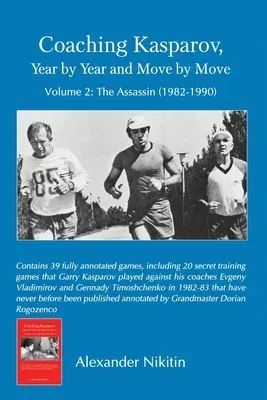*****Short-listed for the English Chess Federation Book of the Year
Award 2020*****
In Coaching Kasparov, Year by Year and Move by Move Garry Kasparov's
long-term coach, second and mentor Alexander Nikitin tells the story of
how he trained Kasparov from a brilliant but raw junior into becoming
and then remaining the world champion. Volume II, the present work,
covers the period 1982-1990, including the first four world championship
matches against Karpov and the candidates matches against Smyslov,
Korchnoi and Beliavsky.
The present volume contains 39 fully annotated games. These include 20
secret training games that Kasparov played against his grandmaster
coaches Evgeny Vladimirov and Gennady Timoshchenko in 1982-83 that have
never before been published and which are annotated by Grandmaster
Dorian Rogozenco, national coach of the German Chess Federation and
captain of the German national team. These games are provided by the
Kasparov family specially for the 2020 edition of this book. The reader
has a unique opportunity to gain an insight into Kasparov's secret
preparation in those years, which were a new starting point in his
career: he had to adjust his openings. Rogozenco is a big expert on
Kasparov's games, having helped FIDE World Champion Ruslan Ponomariov
prepare for his planned match against Kasparov in 2003.
Kasparov's legendary opening repertoire, which was to define trends in
chess theory for decades, was created not just through deep analysis,
but also via training games. The never previously published material in
this book consists of 16 games with classical time control and 4 rapid
thematic games. Testing the Catalan for the first time with white,
searching for ideas in the King's Indian with black, preparing the
Queen's Gambit with both colors, playing typical Sicilian positions and
trying new openings (for instance the Tarrasch as the big surprise for
his candidates match versus Beliavsky) - all this can be found in these
games.
Further, the time records on most of Kasparov's original scoresheets
(all of them pictured in this book) show that Kasparov and his coaches
paid serious attention to such an important training aspect as the
distribution of time during the game.
From intuitive positional sacrifices to precisely calculated
combinations and instructive play in typical pawn structures - the
training games provide a lot of interesting material for both players
and coaches.
The other games, annotated by Nikitin, are well known, but Nikitin
explains many of Kasparov's decisions in those games from the point of
view of the world champion's coach, providing the context of his pupil's
thought process and mistakes and tracing his progress as they together
gradually out-thought Korchnoi and then Karpov. He also uses these games
to illustrate and expand upon his coaching advice. His many insights
include the preparation of the "cross-fire" strategy (playing the same
opening against the same opponent with both colors) and a systematic
approach to maintaining time discipline during games based on
chronometric analysis. This makes his commentary quite unique and
instructive, of formidable practical use to budding players, coaches and
parents.

